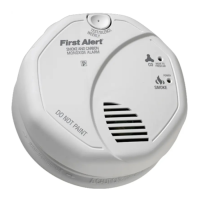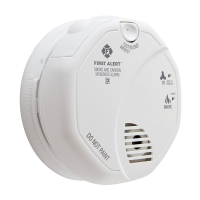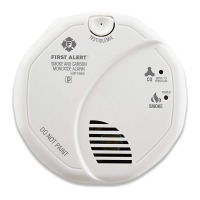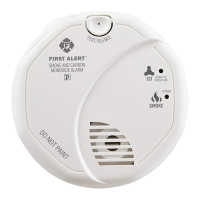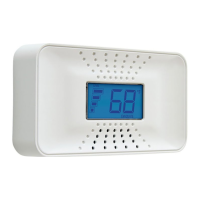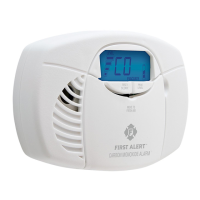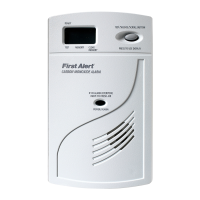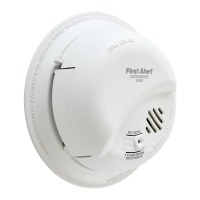ABOUT SMOKE ALARMS
Battery (DC) operated Smoke Alarms: Provide protection even when
electricity fails, pr
ovided the batteries are fresh and correctly installed.
Units ar
e easy to install, and do not require professional installation.
However, they do not provide interconnected functionality.
AC powered Smoke Alarms: Can be interconnected so if one unit
senses smoke, all units alarm. They do not operate if electricity fails.
AC with batter
y (DC) back-up:
will operate if electricity fails, pr
ovided
the batteries are fresh and correctly installed. AC and AC/DC units must
be installed by a qualified electrician.
W
ireless Interconnected Alarms:
Of
fer the same interconnected
functionality as with har
dwired alarms, without wires. Units are easy
to install and do not require professional installation. They provide
pr
otection even when electricity fails, provided the batteries are fresh
and correctly installed.
Smoke/CO Alar
ms for Solar or Wind Energy users and battery
backup power systems: AC powered Smoke/CO Alarms should only
be operated with true or pur
e sine wave inverters. Operating this Alarm
with most battery-powered UPS (uninterruptible power supply) products
or square wave or “quasi sine wave” inverters
will damage the Alarm.
If you ar
e not sure about your inverter or UPS type, please consult with
the manufacturer to verify.
Smoke Alarms for the hearing impaired: Special purpose Smoke
Alarms should be installed for the hearing impaired. They include a
visual alarm and an audible alarm hor
n, and meet the requirements of
the Americans With Disabilities Act. Can be interconnected so if one
unit senses smoke, all units alarm.
Smoke alarms are not to be used with detector guards unless the
combination has been evaluated and found suitable for that purpose.
All these Smoke Alarms ar
e designed to provide early warning of fires if
located, installed and car
ed for as described in the user’s manual, and if
smoke r
eaches the Alarm. If you are unsure which type of Smoke Alarm
to install, r
efer the National Fire Protection Association (NFPA) Standard
72 (National Fire Alarm Code) and NFPA 101 (Life Safety Code).
National Fir
e Protection Association, One Batterymarch Park, Quincy, MA
02269-9101. Local building codes may also require specific units in new
construction or in different areas of the home.
SPECIAL COMPLIANCE CONSIDERATIONS
This unit alone is not a suitable substitute for complete fir
e detection
systems in places housing many people—like apar
tment buildings,
condominiums, hotels, motels, dor
mitories, hospitals, long-term
health car
e facilities, nursing homes, day care facilities, or group
homes of any kind—even if they wer
e once single-family homes.
It is not a suitable substitute for complete fire detection systems
in war
ehouses, industrial facilities, commercial buildings, and
special-purpose non-r
esidential buildings which require special
fire detection and alarm systems. Depending on the building codes
in your ar
ea, this unit may be used to provide additional protection
in these facilities.
The following information applies to all five types of buildings listed
below:
In new construction, most building codes r
equire the use of AC or AC/DC
power
ed Smoke Alarms only. AC, AC/DC, DC or Wireless DC powered
Smoke Alarms can be used in existing construction as specified by
local building codes. Refer to NFP
A 72 (National Fire Alarm Code) and
NFP
A 101 (Life Safety Code), local building codes, or consult your Fire
Department for detailed fire protection requirements in buildings not
defined as “households.”
1. Single-Family Residence:
Single family home, townhouse. It is recommended this unit be installed
on every level of the home, in every bedroom, and in each bedroom
hallway
.
2. Multi-Family or Mixed Occupant Residence:
Apartment building, condominium. This unit is suitable for use in
individual apartments or condos, pr
ovided a primary fire detection
system alr
eady exists to meet fire detection requirements in common
areas like lobbies, hallways, or porches. Using this unit in common areas
may not pr
ovide sufficient warning to all residents or meet local fire
protection ordinances/regulations.
3. Institutions:
Hospitals, day car
e facilities, long-term health care facilities. This unit is
suitable for use in individual patient sleeping/resident rooms, provided
a primary fire detection system already exists to meet fire detection
r
equirements in common areas like lobbies, hallways, or porches. Using
this unit in common areas may not provide sufficient warning to all
residents or meet local fire protection ordinances/regulations.
4. Hotels and Motels:
Also boarding houses and dormitories. This unit is suitable for use inside
individual sleeping/resident rooms, provided a primary fire detection
system already exists to meet fire detection requirements in common
areas like lobbies, hallways, or porches. Using this unit in common areas
may not provide sufficient warning to all residents or meet local fire
protection ordinances/regulations.
5. Warehouses/Commercial Buildings:
DO NOT use this Smoke/CO Alarm in warehouses, industrial or
commercial buildings, special-purpose non-residential buildings, RVs,
boats, or airplanes. This Smoke/CO Alarm is specifically designed
for residential use, and may not provide adequate protection in non-
residential applications.
10
This Smoke/CO Alarm is intended for residential use. It is not intended
for use in industrial applications where Occupational Safety and Health
Administration (OSHA) r
equir
ements for Carbon Monoxide Alarms must
be met. The Smoke Alarm portion of this device is not intended to alert
hearing impaired residents. Special purpose Smoke Alarms should be
installed for hearing impaired residents (CO Alarms are not yet available
for the hearing impaired).
Smoke/CO Alarms may not waken all individuals. Practice the
escape plan at least twice a year
, making sur
e that everyone is involved
– from kids to grandparents. Allow children to master fire escape
planning and practice before holding a fire drill at night when they are
sleeping. If childr
en or others do not r
eadily waken to the sound of the
Smoke/CO Alarm, or if ther
e ar
e infants or family members with mobility
limitations, make sure that someone is assigned to assist them in fire
drill and in the event of an emergency. It is recommended that you hold
a fire drill while family members are sleeping in order to determine their
response to the sound of the Smoke/CO Alarm while sleeping and
to determine whether they may need assistance in the event of an
emergency.
Smoke/CO Alarms cannot work without power. Battery operated
units cannot work if the batteries are missing, disconnected or dead, if
the wrong type of batteries are used, or if the batteries are not installed
corr
ectly
. AC units cannot work if the AC power is cut of
f for any reason
(open fuse or circuit breaker, failure along a power line or at a power
station, electrical fire that burns the electrical wires, etc.). If you are
concerned about the limitations of battery or AC power, install both
types of units.
This Smoke/CO Alar
m will not sense smoke or CO that does not
reach the sensors.
It will only sense smoke or CO at the sensor. Smoke
or CO may be pr
esent in other areas. Doors or other obstructions may
affect the rate at which CO or smoke reaches the sensors. If bedroom
doors are usually closed at night, we recommend you install an alarm
device (Combination CO and Smoke Alarm, or separate CO Alarms and
Smoke Alarms) in each bedroom and in the hallway between them.
This Smoke/CO Alarm may not sense smoke or CO on another
level of the home. Example: This alarm device, installed on the second
floor, may not sense smoke or CO in the basement. For this reason, one
alarm device may not give adequate early warning. Recommended
minimum protection is one alarm device in every sleeping area, every
bedr
oom, and on every level of your home. Some experts r
ecommend
battery powered Smoke and CO Alarms be used in conjunction with
interconnected AC powered Smoke Alarms. For details, see “About
Smoke Alarms” for details.
Smoke/CO Alarms may not be heard. The alarm horn loudness
meets or exceeds curr
ent UL standar
ds of 85 dB at 10 feet (3 meters).
However, if the Smoke/CO Alarm is installed outside the bedroom, it
may not wake up a sound sleeper or one who has recently used drugs
or has been drinking alcoholic beverages. This is especially true if the
door is closed or only partly open. Even persons who are awake may
not hear the alarm horn if the sound is blocked by distance or closed
doors. Noise from traffic, stereo, radio, television, air conditioner, or other
appliances may also prevent alert persons from hearing the alarm horn.
This Smoke/CO Alarm is not intended for people who are hearing
impair
ed.
The Alar
m may not have time to alar
m befor
e the fir
e itself causes
damage, injury, or death, since smoke from some fires may not
reach the unit immediately. Examples of this include persons
smoking in bed, children playing with matches, or fires caused by
violent explosions r
esulting fr
om escaping gas.
This Smoke/CO Alar
m is not a substitute for life insurance.
Though
this Smoke/CO Alarm warns against increasing CO levels or the presence
of smoke, BRK Brands, Inc. does not warrant or imply in any way that they
will protect lives. Homeowners and renters must still insure their lives.
This Smoke/CO Alarm has a limited life. Although this Smoke/CO
Alarm and all of its parts have passed many stringent tests and ar
e
designed to be as reliable as possible, any of these parts could fail at
any time. Ther
efor
e, you must test this device weekly. The unit should be
replaced immediately if it is not operating properly.
This Smoke/CO Alarm is not foolproof. Like all other electronic
devices, this Smoke/CO Alarm has limitations. It can only detect smoke
or CO that r
eaches the sensors. It may not give early war
ning of the
sour
ce of smoke or CO is in a remote part of the home, away from the
alarm device.
GENERAL LIMITATIONS OF SMOKE/CO ALARMS
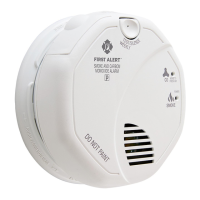
